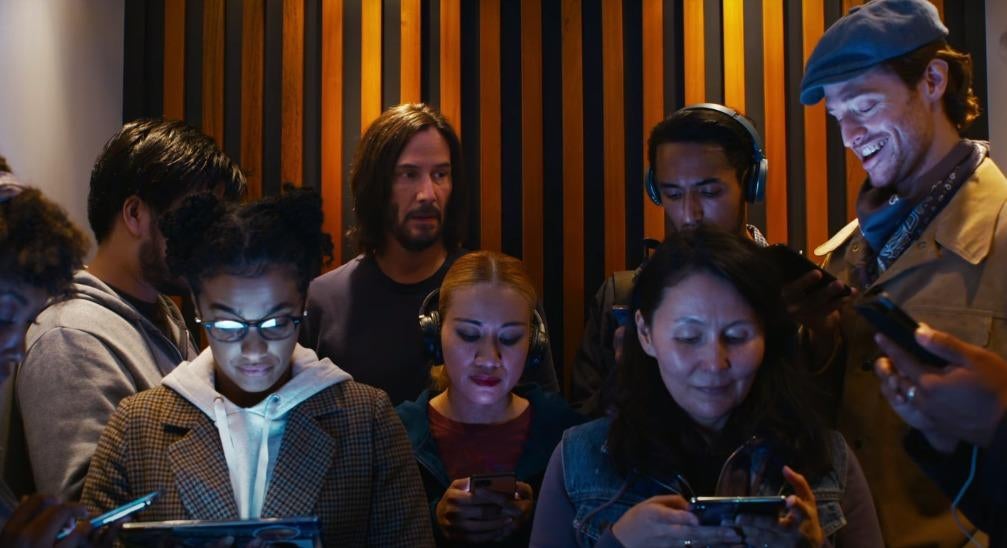There will be The Matrix Resurrections spoilers below. The power of the Matrix is that it’s a narrative device that has both plot and thematic function. In the original 1999 movie, the machine-built simulation is literally a mirage to imprison the human race so they become living batteries, and by that same token it can be seen as a stand-in for expectations ingrained in society or countless other readings. Furthermore, The Matrix has shades of countless other kernels of truth and philosophy, something the Wachowskis would explore breathlessly, sometimes to a fault, in its sequels. The latest entry, The Matrix Resurrections, does all this again but now has the advantage of being released at a time when the real world as we know it has come to resemble the prison built for humanity by the machines even after the franchise collectively freed our minds – namely, the engagement-driven realm of life on social media.
Videos by ComicBook.com
When the first Matrix movie was released, MySpace wouldn’t debut for four more years, Facebook was five years away, and Twitter six years out from existence. The internet was drastically different from how it appears now. Not only were there shifts made in what people share about themselves online both purposefully and unintentionally, but in how companies use all of that to sell ad space and “curate” your “experience.” Not to mention how it all would become a cornerstone of the news cycle and the effect that weaponized accounts on these platforms could have on global politics. It’s all something that Lana and Lilly may not have even realized would happen when they made the first three movies.
The Matrix Resurrections picks up decades after the last movie in the series. Its central mystery of how Neo and Trinity are alive becomes its biggest plot crux, but when the big explanation comes it is also a revealing moment from Lana Wachowski, directing solo this time but having co-written with David Mitchell and Aleksandar Hemon, about their feelings on social media life. Neil Patrick Harris’ The Analyst, a new variation of the stuffy, white-suited Architect from The Matrix Reloaded, plays his hand in full at a critical moment, revealing to Neo the circumstances of he and Trinity’s resurrection and how he used it to shape a new version of The Matrix.
Previous versions of the Matrix were constructed out of mathematical precision to keep people’s minds in check and, even with the anomaly of “The Cycle of The One,” there was an opportunity to break free. The new version of The Matrix relies more on an emotional response to the simulation than its predecessor. In other words, it focuses on engagement, just like Facebook, Twitter, Instagram, TikTok, etc. The new version of The Matrix is concerned with manipulating the minds of those within it by appealing to their feelings rather than feeding them facts. (Sound familiar? Have you been on Twitter in the past 6 years?) This change is stated outright by The Analyst, but also observable in the film as Keanu Reeves’ Neo finds himself awash in a sea of people hooked to their smartphones.

“You don’t give a sh-t about facts,” Harris’ Analyst says about midway through the movie. “And you people believe the craziest sh-t. Why? What validates and makes your fictions real? Feelings. Here’s the thing about feelings, they’re so much easier to control than facts. Turns out, in my Matrix, the worse we treat you, the more we manipulate you, the more energy you produce. It’s nuts. I’ve been setting productivity records every year since I took over. And, the best part, zero resistance. People stay in their pods, happier than pigs in sh-t.”
At the start of that very monologue, Harris also reveals to Neo: “Did you know hope and despair read exactly the same in code?” It’s irrelevant to the Matrix how the people inside act, what messages are pumped into their brains and forced in front of their faces – they’re trapped either way, and worse still, they’re simply commodities for further manipulation.
A 2018 article from Science Focus details how social media sites construct their apps and page with the same tactics as casinos and gambling machines. “Once you’re trapped in a spiral of infinite scrolling, social media apps don’t want you to look up,” Catherine Price writes. It’s the same way that the new version of The Matrix has trapped both Neo and Trinity in cycles, loops that rival the day-to-day life of everyone else stuck in the cogs of the Machines’ machine. It kept them there for decades, using their desire and longing for each other, for real human contact, as a means to keep countless others imprisoned.
There’s also the matter of “The more we manipulate you, the more energy you produce” as studies have also already proven that negative social media posts are more likely to spur engagement than positive ones. Cambridge University published a paper over the summer that looked at social media messaging from US Congress members with “negative language” in such posts increasing engagement “by up to 45% per word” while positive word use “decreased sharing by 2-5%.”
“I feel tremendous guilt… I think we have created tools that are ripping apart the social fabric of how society work,” Chamath Palihapitiya, former vice president for user growth at Facebook, said back in 2017 at Stanford University’s Graduate School of Business.
Another key factor of this new version of the Matrix and how it was clearly influenced by modern social media is in The Analyst’s secret weapon, something he calls Swarm Mode. While the original version of the Matrix had its stuffy-suit wearing, sunglasses-clad Agents, the new Matrix hides its weapons in plain sight. Regular people that walk around and seem normal, perhaps a mind yet to be freed, are actual mindless drones that can be activated by The Analyst to do their bidding. While fighting off an unending group of them in the film, one hacker simply laments, “I hate bots.”
Research out of Carnegie Mellon University in the summer of 2020 found that nearly half of all tweets about the coronavirus at the time were potentially bots. These automated accounts aren’t exclusive to that topic either, pushing other political agendas and even harassing users on the platform for things as trivial as opinions on Star Wars or even The Matrix.
At its core, the entire Matrix franchise is one about reminding everyone that oppression exists on a grand scale worldwide, that people are kept down for specific reasons, and that breaking free of these confines will lead to a better understanding of humanity and the means of which to help others, if you want it to mean that. There are probably a thousand different interpretations you can glean about The Matrix Resurrections from watching it, and the movie evens poke fun at you a little for shrinking the entire experience down into just one, but there’s a clear indictment of social media in the new film, right down to the language we use to talk about Twitter interactions being co-opted for the sequel’s new version of the Matrix.
To boil it down even further, Jessica Henwick’s Bugs drops a thesis for the ages, delivering a line that rings true no matter what lens you’re considering it through but especially for anyone that has dipped their toe into some kind of social media discourse. She tells Neo:
“They took your story, something that meant so much to people like me, and turned it into something trivial…That’s what the Matrix does. It weaponizes every idea. Every dream. Everything that’s important to us.”








